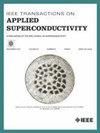Simulation of Quench Behavior in CS LTS Magnets for Next-Generation Fusion Devices With Time-Varying Operation
IF 1.8
3区 物理与天体物理
Q3 ENGINEERING, ELECTRICAL & ELECTRONIC
引用次数: 0
Abstract
In the next generation of fusion devices, the central solenoid (CS) coil needs to withstand large alternating currents and rapidly changing magnetic fields to achieve plasma breakdown, configuration formation, and control. In this study, the quench behavior of a representative submodule (CS1U-LTS) is investigated under time-varying current and magnetic field conditions, where the local field ramp rate reaches approximately 2.5 T/s. This alternating operation mode significantly affects the stability of superconducting magnets. However, the current simulation of superconducting magnet quench is mostly based on the steady-state current and steady-state background field, which makes it difficult to reflect the quench propagation characteristics of superconductors under alternating conditions as the current and magnetic field intensity and direction change. To ensure the safe operation of the CS coils under alternating conditions, this article first analyzes the quench behavior in a reference case with constant peak current prior to an exponential discharge and determines the protection thresholds required to limit the hotspot temperature to below 150 K:200 mV voltage threshold and 0.5 s time threshold. The quench response at the positive and negative current peaks during time-varying operation is further analyzed. The results show that under the same protection conditions, the maximum temperature of the CS1U-LTS coil in alternating operation still meets the design requirements. In addition, this article compares the differences in quench propagation near the two peak points, revealing the impact of alternating operation on quench propagation behavior.用于下一代时变核聚变装置的CS - LTS磁体的淬火行为模拟
在下一代聚变装置中,中央螺线管(CS)线圈需要承受大的交流电和快速变化的磁场,以实现等离子体击穿、配置形成和控制。在本研究中,研究了具有代表性的子模块(CS1U-LTS)在时变电流和磁场条件下的淬火行为,其中局部场斜坡速率约为2.5 T/s。这种交变工作方式对超导磁体的稳定性影响很大。然而,超导磁体猝灭的电流模拟多基于稳态电流和稳态背景场,难以反映交变条件下超导体随电流、磁场强度和方向变化的猝灭传播特性。为了保证CS线圈在交变条件下的安全运行,本文首先分析了指数放电前峰值电流恒定的参考情况下的淬火行为,确定了将热点温度限制在150k以下所需的保护阈值:200mv电压阈值和0.5 s时间阈值。进一步分析了时变运行时电流正、负峰值处的猝灭响应。结果表明,在相同的保护条件下,CS1U-LTS线圈交变运行时的最高温度仍然满足设计要求。此外,本文还比较了两个峰值点附近的淬火传播差异,揭示了交替运行对淬火传播行为的影响。
本文章由计算机程序翻译,如有差异,请以英文原文为准。
求助全文
约1分钟内获得全文
求助全文
来源期刊

IEEE Transactions on Applied Superconductivity
工程技术-工程:电子与电气
CiteScore
3.50
自引率
33.30%
发文量
650
审稿时长
2.3 months
期刊介绍:
IEEE Transactions on Applied Superconductivity (TAS) contains articles on the applications of superconductivity and other relevant technology. Electronic applications include analog and digital circuits employing thin films and active devices such as Josephson junctions. Large scale applications include magnets for power applications such as motors and generators, for magnetic resonance, for accelerators, and cable applications such as power transmission.
 求助内容:
求助内容: 应助结果提醒方式:
应助结果提醒方式:


